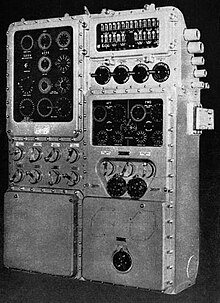
Back کۆمپیوتەری داتای تۆرپیدۆ CKB Torpedovorhaltrechner German Torpedo Data Computer Polish Torpedo Data Computer Russian டார்பிடோ டேட்டா கணினி Tamil

The Torpedo Data Computer (TDC) was an early electromechanical analog computer used for torpedo fire-control on American submarines during World War II. Britain, Germany, and Japan also developed automated torpedo fire control equipment, but none were as advanced as the US Navy's TDC(?),[1] as it was able to automatically track the target rather than simply offering an instantaneous firing solution. This unique capability of the TDC set the standard for submarine torpedo fire control during World War II.[2][3]
Replacing the previously standard hand-held slide rule-type devices (known as the "banjo" and "is/was"),[4] the TDC was designed to provide fire-control solutions for submarine torpedo firing against ships running on the surface (surface warships used a different computer).[5]
The TDC was a rather bulky addition to the sub's conning tower and required two extra crewmen: one as an expert in its maintenance, the other as its actual operator. Despite these drawbacks, the use of the TDC was an important factor in the successful commerce raiding program conducted by American submarines during the Pacific campaign of World War II. Accounts of the American submarine campaign in the Pacific often cite the use of TDC.[6][7] Some officers became highly skilled in its use,[8] and the Navy set up a training school for operation of the device.[9]
Two upgraded World War II-era U.S. Navy fleet submarines (USS Tusk and Cutlass) with their TDCs continue to serve with Taiwan's navy and U.S. Nautical Museum staff are assisting them with maintaining their equipment.[10] The museum also has a fully restored and functioning TDC from USS Pampanito, docked in San Francisco.
- ^ Friedman, Norman (1995). US Submarines Through 1945: An Illustrated Design History. Naval Institute Press. p. 195. ISBN 1-55750-263-3.
- ^ "Analog Computers". Lexikon's History of Computing. 1995. Archived from the original on 2012-08-14. Retrieved 2006-07-03.
- ^ While the TDC's target tracking abilities were unique for submarine torpedo fire control during WWII, target tracking was used on surface ship torpedo fire control systems by a number of nations (see references in this article to US destroyer and Japanese torpedo fire control Archived 2007-07-20 at the Wayback Machine). The TDC was the first analog computer to miniaturize the capability enough for deployment on a submarine.
- ^ Beach, Run Silent, Run Deep
- ^ "Torpedo Fire Control Equipment (Destroyer Type)".
- ^ O'Kane, Richard (1977). Clear The Bridge:The War Patrols of the U.S.S. Tang. New York: Bantam Books. ISBN 0-553-14516-9.
- ^ O'Kane, Richard (1987). Wahoo: The Patrols of America's Most Famous World War II Submarine. New York: Bantam Books. ISBN 0-553-28161-5.; Beach, Edward L., Jr., Captain, USN (rtd). Run Silent, Run Deep, passim; Beach, Dust on the Sea, passim; Grider, George. War Fish, passim; Blair, Clay, Jr. Silent Victory (New York: Bantam, 1976), passim.
- ^ Dusty Dornin was widely agreed to be the best. Blair, p.357.
- ^ Blair, p.357.
- ^ "Museum documents an operating US, WW II built submarine in Taiwan". Retrieved 2008-07-13.